Fujifilm FinePix S9500 Zoom / FinePix S9000 Zoom review
-
-
Written by Gordon Laing
Fujifilm’s FinePix S9500 is designed to resemble a budget digital SLR in style and operation. Measuring 128x93x129mm, it’s virtually the same size as the Canon EOS-350D / Digital Rebel XT equipped with its 18-55mm kit lens – although of course the S9500 has a much longer zoom range, details of which are on the next page. It’s pictured below next to its 12x-zoom rival the Panasonic DMC-FZ30.
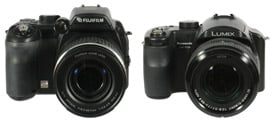
Unlike most SLRs which have their lens mounts roughly in the middle of the body though, the S9500 has it’s lens barrel shifted to one side. This leaves plenty of room for a decent sized grip and your fingers to hold onto it without them being pinched by the lens barrel. Overall build quality is to a very high standard, although not quite up to the feel of Panasonic’s FZ30.
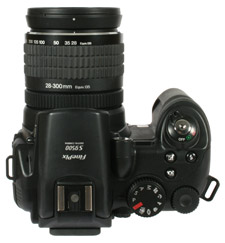
The S9500 is packed with buttons and controls, with most located on the upper right surface and to the right of the main display. The main Command dial offers Auto, Program, Manual, Shutter and Aperture Priority modes, along with five scene presets and a movie mode. Shutter speeds range from 1/4000 to 30 seconds.
The Command dial’s joined by exposure compensation, flash and continuous shooting buttons with a thumb-wheel to adjust their options. The shutter release button sits inside the main power switch which selects between Record, Play and off. Following Fujifilm’s tradition on its higher-end cameras, the shutter release button is threaded for an old-fashioned cheap cable release – a welcome touch in an age where pricey electronic cable releases are the norm.
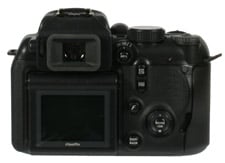
The rear of the camera is home to many more controls including the usual four-way joypad, the main menu button, a metering mode dial with exposure lock, and buttons to switch between the screen and EVF along with their display options.
There’s also Fujifilm’s ‘F’ button which brings up quality, ISO and colour tone options, although for white balance settings you’ll need to enter the main menu system. It seems odd not to have white balance included on the F menu, or for that matter not to have dedicated buttons for both white balance and ISO for use with the thumb-wheel. This would give the S9500 much more of the SLR feel Fujifilm is clearly aiming for.
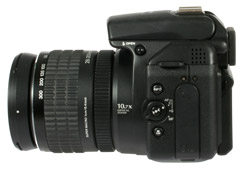
A button to the left of the flash pops it open, upon which you can change its settings by pressing the dedicated button and turning the thumb-wheel; there’s red-eye reduction and slow synchro options, along with modest flash compensation settings of +/-2/3 EV via the main menu. There’s also a basic hotshoe and a PC-Sync port.
The camera’s powered by four AA batteries, and Fujifilm supplies a set of disposable Alkalines to get you started. We managed to go through these in just a couple of days testing though (albeit mostly using the 60 fps display mode, see later), so the sooner you replace them with a set of rechargeables and a charger, the better. Some people prefer AAs for their wide availability, but personally we’d sooner have a rechargeable Lithium Ion pack every time. They’re smaller, lighter and generally last longer.
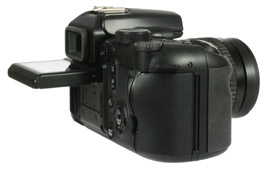
Finepix S9500 / S9000 zoom composition and screen
Like other all-in-one cameras with long zooms, the S9500 offers the choice of composing with either a colour LCD screen or electronic viewfinder, EVF. The 0.44in 230,000 pixel EVF is large and detailed, matching that on the Panasonic FZ30. The S9500’s main screen is smaller and less detailed than its rival though, measuring a fairly modest 1.8in with 118,000 pixels. A button to the right of the viewfinder switches between the EVF and main screen.
The main screen is hinged at the top and bottom, allowing it to be flipped 90 degrees upwards for waist-level shooting, or tilted back by about 40 degrees. Sadly it can’t be twisted sideways, nor flipped back on itself to protect the screen’s surface. In this respect it’s nowhere as flexible as the fully-flippable screens of the Panasonic FZ30, Sony DSC-R1 or a number of Canon compacts, but it is at least more flexible than a conventional digital SLR.
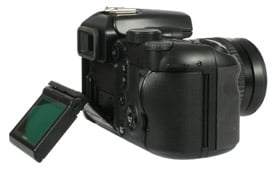
The display button allows you to compose with three by three grid lines or view a shrunken image with thumbnails of the previous three shots running down the left side. An info button on the side of the camera fires up the live histogram or shows further shooting information.
There’s an option to switch the refresh rate of the screen from the standard 30 fps to a ‘High Speed’ 60 fps mode. This is far preferable in use, delivering both a smoother image on the screen and greatly reducing the clicking sound as the camera adjusts the exposure for different conditions. It does however seem to eat through your batteries more quickly, again illustrating the need to get a set of decent rechargeables ASAP.




